Advertisements
Advertisements
Question
A 100 pF capacitor is charged to a potential difference of 24 V. It is connected to an uncharged capacitor of capacitance 20 pF. What will be the new potential difference across the 100 pF capacitor?
Solution
Given :
`C_1 = 100 "pF"`
V = 24 V
Charge on the capacitor `q = C_1V = 24 xx 100 "pC"`
Capacitance of the uncharged capacitor, `C_2 = 20 "pF"`
When the charged capacitor is connected with the uncharged capacitor, the net charge on the system of the capacitors becomes
`q_1 + q_2 = 24 xx 100 "qC"` ....(i)
The potential difference across the plates of the capacitors will be the same.
Thus,
`q_1/C_1 = q_2/C_2`
⇒ `q_1/100 = q_2/20`
⇒ `q_1 = 5q_2` ....................(ii)
From eqs. (i) and (ii), we get
`q_1+q_1/5 = 24 xx 100 "pc"`
⇒ `6q_1 = 5 xx 24 xx 100 "pC"`
⇒ `q_1 = (5xx24xx100)/(6) "pC"`
Now ,
`V_1 = q_1/C_1`
⇒ `(5xx24xx100 "pC")/(6xx100 "pF")` = 20 V
APPEARS IN
RELATED QUESTIONS
Define 1 volt PD.
The potential difference applied across a given resistor is altered so that the heat produced per second increases by a factor of 9. By what factor does the applied potential difference change?
In the circuit diagram given below, AB is a uniform wire of resistance 15 Ω and length 1 m. It is connected to a cell E1 of emf 2V and negligible internal resistance and a resistance R. The balance point with another cell E2 of emf 75 mV is found at 30 cm from end A. Calculate the value of R.
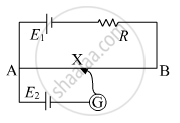
Explain the principle of a device that can build up high voltages of the order of a few million volts.
Draw a schematic diagram and explain the working of Van de Graff generator device.
The figure shows a plot of three curves a, b, c, showing the variation of photocurrent vs collector plate potential for three different intensities I1, I2and I3 having frequencies v1, v2 and v3 respectively incident of a photosensitive surface.
Point out the two curves for which the incident radiations have same frequency but different intensities.
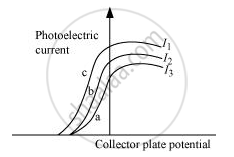
Find the potential difference `V_a - V_b` between the points a and b shown in each part of the figure.
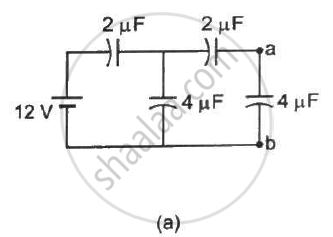
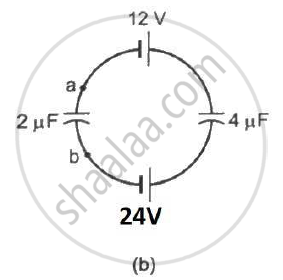
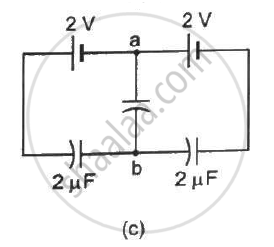
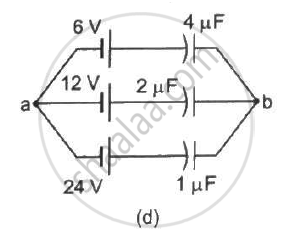
Find the potential difference between the points A and B and between the points B and C of the figure in steady state.

A charge of `+2.0 xx 10^-8 C` is placed on the positive plate and a charge of `-1.0 xx 10^-8 C` on the negative plate of a parallel-plate capacitor of capacitance `1.2 xx 10^-3 "uF"` . Calculate the potential difference developed between the plates.
A charge of 20 µC is placed on the positive plate of an isolated parallel-plate capacitor of capacitance 10 µF. Calculate the potential difference developed between the plates.
A capacitor having a capacitance of 100 µF is charged to a potential difference of 50 V. (a) What is the magnitude of the charge on each plate? (b) The charging battery is disconnected and a dielectric of dielectric constant 2⋅5 is inserted. Calculate the new potential difference between the plates. (c) What charge would have produced this potential difference in absence of the dielectric slab. (d) Find the charge induced at a surface of the dielectric slab.
If a positive charge moves in the direction of the electric field ______.
The unit of potential difference as used in electrical circuits is ________.
On moving a charge of Q coulomb by X cm, W J of work is done, then the potential difference between the points is ______.
A and B are two points in an electric field. If the work done in carrying 4.0C of electric charge from A to B is 16.0 J, the potential difference between A and B is:
An α-particle and a proton are accelerate at same potential difference from rest. What will be the ratio of their final velocity?
